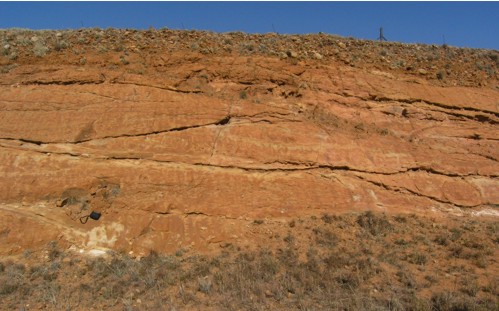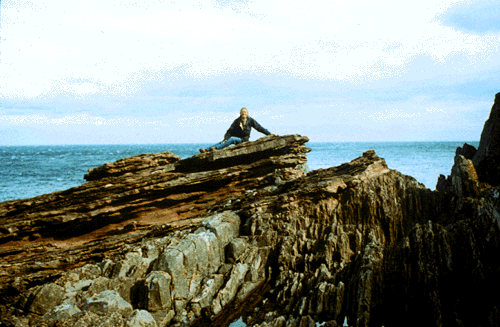This was the first outcrop we stopped at on our last field trip:

Most of the outcrop consists of coarse sandstones, complete with down-cutting channels and cross-bedding, and the occasional conglomerate horizon.

At the top, there’s a contact with an unconsolidated conglomerate, which (from the red colour) appears to have been fairly pervasively weathered over long periods of exposure. So far, so not-particularly-interesting (although Brian or Kim may beg to differ) – but only until you start to investigate the age of the two different units. The lower sandstone and congolmerate unit can be traced into other areas, where it is sandwiched between lava units which have radiometric dates of about 2.7 billion, or 2700 million, years (they’re part of the Ventersdorp Supergroup). In contrast, minerals formed by weathering reactions at the contact have also been dated, and have an age of only about 15 million years.
So the contact is in fact a massive unconformity: the time between the deposition of the two units in this outcrop is somewhere in the region of 2680 million years, which is a fairly sizeable chunk of geological history. But the really mind- blowing part is exactly how little seems to have happened, geologically, in that missing time. When I think of big uncomformities, I tend to think of something like Hutton’s Uncomformity, found at various places in north-west Scotland:

(image source)
Here, the older, underlying unit (which is, if I recall correctly, somewhere in the region of 600-700 million years old) has been severely warped during the process of uplift and erosion, before the deposition of flat-lying 400 million year-old sediments on top (which have also been tilted slightly by a later tectonic episode). And this is in a time gap of ‘only’ 300 million years or so! Yet here in central South Africa, in almost an order of magnitude more time, not much has happened at all; the Ventersdorp rocks don’t even seem to have been buried very deeply underneath younger sediments that have then been removed by later erosion, because there’s no real signs of the metamorphic minerals that would have formed at the increased temperature and pressure that would have resulted.
So, when your hear geologists talking about ‘stable cratonic interiors’, this is what they mean: very old rocks just sitting there, letting all the geology happen somewhere else. On this particular field trip, this starting outcrop was a useful point of comparison to the numerous belts of much more deformed rocks we passed through on our journey to the west coast, testaments to multiple bouts of continental collision that went unnoticed further inland.



Comments (6)
Links (1)-
Pingback: The flat of the land | Highly Allochthonous